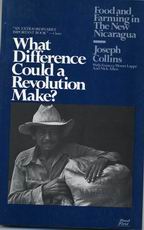
What Difference Could a Revolution Make?
Food and Farming in The New Nicarauga
Collins, Joseph; with Lappe, Moore Frances; and Allen, Nick
Publisher: Food First
Year First Published: 1982
Year Published: 1983
Pages: 179pp ISBN: 0-935028-10-2
Library of Congress Number: HD1817.C64 Dewey: 338.1'097285
Resource Type: Book
Cx Number: CX11521
Reports on the dramatic changes brought by the first three years of the Sandinista revolution.
Abstract:
After the Nicaraguan people toppled the Somoza government in 1979, the country underwent significant social, political, and economic changes. The Sandinista-led popular insurrection ushered in a new era devoted to build a country based on "the logic of the majority." Over the previous century, the richest 10 percent of the population made the important decisions regarding the remaining 90 percent. Working together to analyze the changes in the Nicaraguan countryside as well the national food situation, Joseph Collins, Frances Moore Lappe and editor Nick Allen put together their book What Difference Could a Revolution Make? Food and Farming in The New Nicaragua. The study asks readers to view Nicaragua through "food glasses" believing "Doing so makes it possible to see behind the newspaper accounts which too often transmit only the U.S. government's one-dimensional portrayal of Nicaragua's geopolitical role in the East-West conflict." Reporting on how the Nicaraguan people were affected by the new economic and social policies under Sandinista, the work reveals the complexities involved with societal transformations on such a large scale. The authors believe that "hunger can only be eliminated through political and economic changes that redistribute power over food-producing sources" and discuss how the Sandinista government could take measures to ensure it would happen. The book specifically allows for a better understanding of Nicaraguans themselves, showing readers the perspective of poor farmers fighting for the basic necessities of subsistence and daily life. Considering Nicaragua's troubled history, the battles between the rich landowning few and the poor peasant majority, the case study presents several important observations helping to tell the story of the country's past as well as provide suggestions to improve the situation for the future.
[Abstract by William Stevenson]
Table of Contents
List of Tables
Acknowledgments
1. Nicaragua is a School
2. Imagine You Were a Nicaraguan
3. The Peasants' Victory
4. No Ownership Without Obligation
5. Failed Partnership: Big Growers and the State
6. Spilling Credit in the Countryside
7. The State Farm: Discredited Model or Pragmatic Adaptation?
8. Wage and Productivity Dilemmas
9. Is Seizing the Land Revolutionary?
10. A Conservative Agrarian Reform?
11. Cooperative Work: Will it Work in Nicaragua?
12. Corn and Beans First
13. Can the Market Feed the Poor?
14. Reflections
Tables
Nicaraguan Political History
Sources Consulted
Nicaragua Resource Guide
Subject Headings


